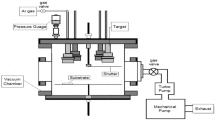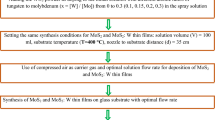Abstract
MoOx films were deposited using reactive sputtering of Mo under varying oxygen flow in the plasma ambient. The films showed a broad X-ray diffraction peak corresponding to MoOx structure. The surface morphology has been influenced significantly with the oxygen content in the plasma during the process of film deposition. The as-deposited films were porous at lower oxygen flow rate (< 10 sccm), while it showed coarse structure at the higher flow rates (> 15 sccm). The compositional analysis revealed that the films are sub-stoichiometric and the weight ratio of O/Mo varied from 1.5 to 2 in the O2 flow range of 5–25 sccm. The sub-stoichiometric phases of MoO3 were detected from FTIR analysis. The optical characteristics showed that the films were highly transparent (> 85%) in the visible region, and exhibited direct band gap energy of 3.66 eV. The optical constants, i.e., refractive index (n) and extinction coefficient (k) evaluated from spectroscopic ellipsometry were found to be 2.03 and 0.0035, respectively at the wavelength of 600 nm, for the films deposited at the optimum conditions. The films showed a broad luminescence with a strong emission at 400 nm, which would help improve the blue response of solar cells. The Al/MoOx/Si device showed a maximum barrier height, \({\phi }_{b}\) ~0.86 eV and a minimum leakage current, Io ~ 5.81 × 10–11 A at the higher O2 flow rates (> 15 sccm), which changed significantly with the oxygen flow rate. The study demonstrates the tunability of structural and optical characteristics, which have been significantly influenced by tuning the plasma ambient during the film deposition.











Similar content being viewed by others
Data availability
All data generated or analyzed during this study are included in this article.
References
M.M. Makhlouf, H. Khallaf, M.M. Shehata, Impedance spectroscopy and transport mechanism of molybdenum oxide thin films for silicon heterojunction solar cell application. Appl. Phys. A 128, 98 (2022). https://doi.org/10.1007/s00339-021-05215-z
C.S. Hsu, C.C. Chan, H.T. Huang, C.H. Peng, W.C. Hsu, Electrochromic properties of nanocrystalline MoO3 thin films. Thin Solid Films 516(15), 4839–4844 (2008). https://doi.org/10.1016/j.tsf.2007.09.019
R. Yordanov, S. Boyadjiev, V. Georgieva, L. Vergov, Characterization of thin MoO3 films formed by RF and DC-magnetron reactive sputtering for gas sensor applications. J. Phys. Conf. Ser. (2014). https://doi.org/10.1088/1742-6596/514/1/012040
N. Maheswari, G. Muralidharan, Controlled synthesis of nanostructured molybdenum oxide electrodes for high performance supercapacitor devices. Appl. Surf. Sci. 416, 461–469 (2017). https://doi.org/10.1016/j.apsusc.2017.04.094
H. Luo, K. Wang, F. Lin, F. Lv, J. Zhou, W. Zhang, D. Wang, W. Zhang, Q. Zhang, L. Gu, M. Luo, S. Guo, Amorphous MoOx with high oxophilicity interfaced with PtMo alloy nanoparticles boosts anti-CO hydrogen electrocatalysis. Adv. Mater. 35(29), 1–9 (2023). https://doi.org/10.1002/adma.202211854
J. Scarminio, A. Lourenço, A. Gorenstein, Electrochromism and photochromism in amorphous molybdenum oxide films. Thin Solid Films 302, 66–70 (1997). https://doi.org/10.1016/S0040-6090(96)09539-9
C.G. Granqvist, A. Azens, A. Hjelm, L. Kullman, G.A. Niklasson, D. Rönnow, M. Strømme Mattsson, M. Veszelei, G. Vaivars, Recent advances in electrochromics for smart windows applications. Sol. Energy 63, 199–216 (1998). https://doi.org/10.1016/S0038-092X(98)00074-7
E. Bobeico, L.V. Mercaldo, P. Morvillo, I. Usatii, M.D. Noce, L. Lancellotti, C. Sasso, R. Ricciardi, P.D. Veneri, Evaporated MoOx as general back-side hole collector for solar cells. Coatings 10(1), 763 (2020). https://doi.org/10.3390/COATINGS10080763
S. Subbarayudu, V. Madhavi, S. Uthanna, Growth of MoO3 Films by RF Magnetron Sputtering: Studies on the Structural, Optical, and Electrochromic Properties. Condensed Matter Phys. (2013). https://doi.org/10.1155/2013/806374
A. Tyagi, J. Biswas, K. Ghosh, A. Kottantharayil, S. Lodha, Performance analysis of silicon carrier selective contact solar cells with ALD MoOx as hole selective layer. Silicon 14, 1663–1670 (2022). https://doi.org/10.1007/s12633-021-00984-x
R.S. Patil, M.D. Uplane, P.S. Patil, Structural and optical properties of electrodeposited molybdenum oxide thin films. Appl. Surf. Sci. 252, 8050 (2006). https://doi.org/10.1016/j.apsusc.2005.10.016
I. Safi, Recent aspects concerning DC reactive magnetron sputtering of thin films: A review. Surf. Coatings Technol. 127(2–3), 203 (2000). https://doi.org/10.1016/s0257-8972(00)00566-1
M. Rabizadeh, M.H. Ehsani, M.M. Shahidi, Tuning of physical properties in MoO3 thin films deposited by DC sputtering. Opt. Quantum Electron. 53(12), 1–17 (2021). https://doi.org/10.1007/s11082-021-03360-6
K. Srinivasarao, B. Rajini Kanth, P.K. Mukhopadhyay, Optical and IR studies on r.f. magnetron sputtered ultra-thin MoO3 films. Appl. Phys. A Mater. Sci. Process. 96(4), 985–990 (2009). https://doi.org/10.1007/s00339-009-5132-3
T.S. Sian, G.B. Reddy, Optical, structural and photoelectron spectroscopic studies on amorphous and crystalline molybdenum oxide thin films. Sol. Energy Mater. Sol. Cells 82, 375–386 (2004). https://doi.org/10.1016/j.solmat.2003.12.007
S.H. Mohamed, O. Kappertz, J.M. Ngaruiya, T.P. Leervad Pedersen, R. Drese, M. Wuttig, Correlation between structure, stress and optical properties in direct current sputtered molybdenum oxide films. Thin Solid Films 429(1–2), 135–143 (2003). https://doi.org/10.1016/S0040-6090(03)00068-3
I. Navas, R. Vinodkumar, V.P.M. Pillai, Self-assembly and photoluminescence of molybdenum oxide nanoparticles. Appl. Phys. A 103, 373–380 (2011). https://doi.org/10.1007/s00339-011-6345-9
N. Lopez-Pinto, T. Tom, J. Bertomeu, J.M. Asensi, E. Ros, P. Ortega, C. Voz, Deposition and characterization of sputtered molybdenum oxide thin films with hydrogen atmosphere. Appl. Surf. Sci. 563, 150285 (2021). https://doi.org/10.1016/j.apsusc.2021.150285
H. Mehmood, G. Bektaş, İ Yıldız, T. Tauqeer, H. Nasser, R. Turan, Electrical, optical and surface characterization of reactive RF magnetron sputtered molybdenum oxide films for solar cell applications. Mater. Sci. Semicond. Process. 101, 46–56 (2019). https://doi.org/10.1016/j.mssp.2019.05.018
S. Touihri, A. Arfaoui, Y. Tarchouna, A. Labidi, M. Amlouk, J.C. Bernede, Annealing effect on physical properties of evaporated molybdenum oxide thin films for ethanol sensing. Appl. Surf. Sci. 394, 414–424 (2017). https://doi.org/10.1016/j.apsusc.2016.10.139
I. Kostis, N. Vourdas, G. Papadimitropoulos, A. Douvas, M. Vasilopoulou, N. Boukos, D. Davazoglou, Effect of the oxygen sub-stoichiometry and of hydrogen insertion on the formation of intermediate bands within the gap of disordered molybdenum oxide films. J. Phys. Chem. C 117(35), 18013–18020 (2013). https://doi.org/10.1021/jp407354j
S. Kumari, K. Singh, P. Singh, S. Kumar, A. Thakur, Thickness dependent structural, morphological and optical properties of molybdenum oxide thin films. SN Appl. Sci. 2, 1439 (2020). https://doi.org/10.1007/s42452-020-3193-2
V. Nirupama, K.R. Gunasekhar, B. Sreedhar, S. Uthanna, Effect of oxygen partial pressure on the structural and optical properties of dc reactive magnetron sputtered molybdenum oxide films. Curr. Appl. Phys. 10(1), 272–278 (2010). https://doi.org/10.1016/j.cap.2009.06.005
I. Navas, R. V. Kumar, K. Maniammal, and V. P. M. Pillai. (2011) “Amorphous molybdenum oxide nanorods for electrochromic applications.” Int. Congr. Ultra Mod. Telecommun. Control Syst. Work. 1–5.
M.T. Greiner, M.G. Helander, W.M. Tang, Z. Bin Wang, J. Qiu, Z.H. Lu, Universal energy-level alignment of molecules on metal oxides. Nat. Mater. 11(1), 76–81 (2012). https://doi.org/10.1038/nmat3159
I. Navas, R. Vinodkumar, K.J. Lethy, M. Satyanarayana, V. Ganesan, V.P.M. Pillai, Effect of zinc oxide doping on the structural and optical characterization of nanostructured molybdenum oxide films. J. Nanosci. Nanotechnol. 9(9), 5254–5261 (2009). https://doi.org/10.1166/jnn.2009.1163
P.R. Huang, Y. He, C. Cao, Z.H. Lu, Impact of lattice distortion and electron doping on a-MoO3 electronic structure. Sci. Rep. 4, 7131 (2014). https://doi.org/10.1038/srep07131
X.D. Li, T.P. Chen, P. Liu, Y. Liu, Z. Liu, K.C. Leong, A study on the evolution of dielectric function of ZnO thin films with decreasing film thickness. J. Appl. Phys. 115, 103512 (2014). https://doi.org/10.1063/1.4868338
M. Itoh, K. Hayakawa, S. Oishi, Optical properties and electronic structures of layered MoO3 single crystals. J. Phys. Condens. Matter 13, 6853 (2001). https://doi.org/10.1088/0953-8984/13/31/319
Z. Hussain, Optical and electrochromic properties of heated and annealed MoO3 thin films. J. Mater. Res. 16(9), 2695–2708 (2001). https://doi.org/10.1557/JMR.2001.0369
O. Kamoun, A. Mami, M.A. Amara, R. Vidu, M. Amlouk, Nanostructured Fe, Co-co-doped MoO3 thin films. Micromachines (2019). https://doi.org/10.3390/mi10020138
Y. Zhao, J. Liu, Y. Zhou, Z. Zhang, Y. Xu, H. Naramoto, S. Yamamoto, Preparation of MoO3 nanostructures and their optical properties. J. Phys. Condens. Matter 15, L547–L552 (2003). https://doi.org/10.1088/0953-8984/15/35/101
R.K. Sharma, G.B. Reddy, Synthesis and characterization of MoO3 microspheres packed with nanoflakes. J. Phys. D Appl. Phys. 47(6), 065305 (2014). https://doi.org/10.1088/0022-3727/47/6/065305
I. Navas, R. Vinodkumar, V.P. Mahadevan Pillai, Self-assembly and photoluminescence of molybdenum oxide nanoparticles. Appl. Phys. A Mater. Sci. Process. 103(2), 373–380 (2011). https://doi.org/10.1007/s00339-011-6345-9
R. Garcia-Hernansanza, E. Garcia-Hemmea, D. Monteroa, J. Oleaa, A. del Pradoa, I. Martila, C. Vozb, L.G. Gerlingb, J. Puigdollersb, R. Alcubilla, Transport mechanisms in silicon heterojunction solar cells with molybdenum oxide as a hole transport layer. Solar Energy Mater. Solar Cells 185, 61–65 (2018). https://doi.org/10.1016/j.solmat.2018.05.019
Z.Q. Liu, D.P. Leusink, W.M. Lu, X. Wang, X.P. Yang, K. Gopinadhan, Y.T. Lin, A. Annadi, Y.L. Zhao, A.R. Barman, S. Dhar, Reversible metal-insulator transition in LaAlO3 thin films mediated by intragap defects: an alternative mechanism for resistive switching. Phys. Rev. B (2011). https://doi.org/10.1103/PhysRevB.84.165106
A. Kumar, S.N. Singh, Jyoti, S. Tomer, Vandana, S.K. Srivastava, M. Dutta, P. Pathi, A novel analytical method for determination of diode parameters from the dark forward I—V characteristics of a silicon solar cell. Phys. Scr. (2023). https://doi.org/10.1088/1402-4896/ace55d
H.H. Gullu, D.E. Yildiz, O. Surucu, M. Parlak, Frequency effect on electrical and dielectric characteristics of HfO2-interlayered Si-based Schottky barrier diode. J. Mater. Sci. Mater. Electron. 31, 9394 (2020). https://doi.org/10.1007/s10854-020-03479-4
Acknowledgements
The authors are thankful to CSIR-National Physical Laboratory, New Delhi, for the experimental facilities. The author Abhishek Kumar gratefully acknowledges the support of Ministry of New and Renewable Energy (MNRE), Govt. of India for providing NREF fellowship (Ref. No. 10/2(2)2017-HRD, Dt. 30.03.2018).
Author information
Authors and Affiliations
Contributions
Abhishek Kumar: Writing—original draft, Investigation, Data curation, Conceptualization. Mrinal Dutta: Review & Editing, Data Curation. Shweta Tomer: Data Curation. Pritty Rao: Data Curation. Vandana: Review & Editing, Supervision. Sanjay Kumar Srivastava: Review & Editing. S. N. Singh: Review & Editing, Supervision. Prathap Pathi: Review & Editing, Data curation, Supervision, Resources.
Corresponding author
Ethics declarations
Competing interest
The authors declare that they have no known competing financial interests or personal relationships that could have appeared to influence the work reported in this paper.
Additional information
Publisher's Note
Springer Nature remains neutral with regard to jurisdictional claims in published maps and institutional affiliations.
Rights and permissions
Springer Nature or its licensor (e.g. a society or other partner) holds exclusive rights to this article under a publishing agreement with the author(s) or other rightsholder(s); author self-archiving of the accepted manuscript version of this article is solely governed by the terms of such publishing agreement and applicable law.
About this article
Cite this article
Kumar, A., Dutta, M., Tomer, S. et al. Tuning of structural and optical properties of reactively sputtered MoOx films. J Mater Sci: Mater Electron 35, 612 (2024). https://doi.org/10.1007/s10854-024-12324-x
Received:
Accepted:
Published:
DOI: https://doi.org/10.1007/s10854-024-12324-x




